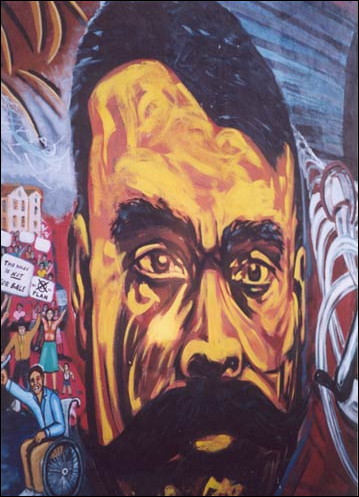

Pilsen Today...
_____________________________________________________
The neighborhoods discussed in Sandra Cisneros's The House On Mango Street are, for all intents and purposes, the area of and around Chicago's Pilsen area: some figuratively, as in the case of the (probably imaginary) Mango Street itself; some, such as Loomis, Keeler and Paulina, literally. Sandra Cisneros herself grew up there, and in many ways her moves from neighborhood to neighborhood within Pilsen mirrored the moves of Esperanza and her family, perhaps lending credence to the idea that The House On Mango Street is at least partly autobiographical.
The Pilsen/Little Village section of Chicago is located southwest of the loop, near the University of Chicago Illinois campus; "stretching east to west from the river to the city limits and north to south from roughly 16th street to the Stevenson expressway." (6) A small map of the neighborhood's boundaries can be found at this website.
Today, Pilsen's primary distinction is its status as the home of the largest part of Chicago's Latino community and even one of the largest Mexican communities in the United States (6); nearly 60 percent of its residents are Mexican or Mexican American. (9) This, however, is a relatively recent development, the bulk of Mexican immigration having occurred since after World War II. Before the Latin American cultural makeover, Pilsen was primarily composed of working class members of Slavic and Irish ethnicities (10) and considered "a national center of labor activism." (6) Before that, it was mainly German, and before that, it was a center for Czech immigration in Chicago, incidentally where the neighborhood got its name. The Czech community--many of whom worked in the city's famous stockyards--named their Chicago district after the second largest city of their homeland in the late 19th century (10). They also established the sokols that remain in the area to this day, helping to create a distinct flavor in modern Pilsen, quite unlike Mexico in spite of its current ethnic makeup.
The significance of Pilsen to The House On Mango Street is great. As a native of a predominantly Latin American community in the midst of a still-predominantly white city, Esperanza experiences both the cultural wealth and the alienation from the mainstream world around her that one would expect from a young girl in her situation. Furthermore, as her family moves up and out to more "upscale" neighborhoods, she more fully realizes the "culture shock" of encountering an outside world quite different from the Mexican American pocket in which she lives. Pilsen simultaneously serves as a comforting childhood home for Mango Street's young protagonist and as the fetters that anchor her to poverty, inequity and sociocultural marginalization. Its dualistic history--simultaneously European, American and Mexican, and yet really none of them at all--in a way mirrors Esperanza and perhaps even Cisneros herself. She is Mexican, she is American, and yet, she is neither. One can see Cisneros writing for her main character a lovingly detailed, heartfelt ode to her (their) neighborhood, even as Esperanza yearns for a way out; such is one of the many dichotomies that makes Pilsen, Cisneros's Pilsen, what it is today.
"One day I will pack my bags of books and paper. One day I will say goodbye to Mango. I am too strong for her to keep me here forever. One day I will go away.
"Friends and neighbors will say, What happened to that Esperanza? Where did she go with all those books and paper? Why did she march so far away?
"They will not know that I have gone away to come back. For the ones I left behind. For the ones who cannot out." (1)
_____________________________________________________

* Top Picture: "The eagle is symbolic of the Mexican roots of the Chicano movment, which tried to raise the status and rights of Mexican Americans--especially the farm laborers-- in the 1970s/80s. Corn is everywhere the 'staff of life,' just as bread (or potatoes!) is in other traditions. The large head is that of Emiliano Zapata, the Mexican revolutionary who identified strongly with the farming peasants and who is a continuing inspiration for the downtrodden. As you may recall, this mural is particularly critical of the 'gentrification' of the Hispanic Pilsen district, focussing [sic] on the growing takeover of this area by weather capitalists." Pictures From Chicago, Decorah, and Madison, 2003: Lone's Pictures
* Bottom Picture: Pilsen, Chicago. October 6, 2001. Photo by Jesse Worker.